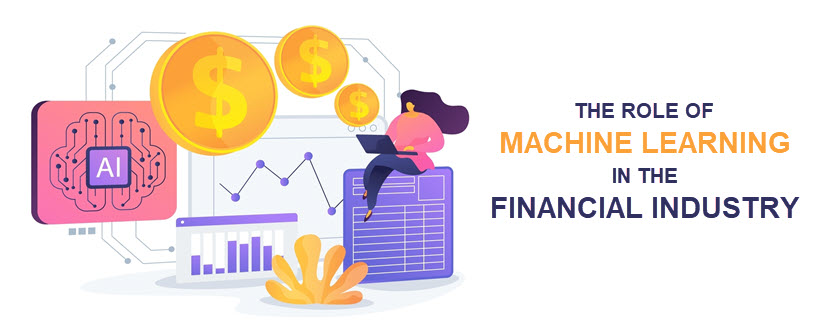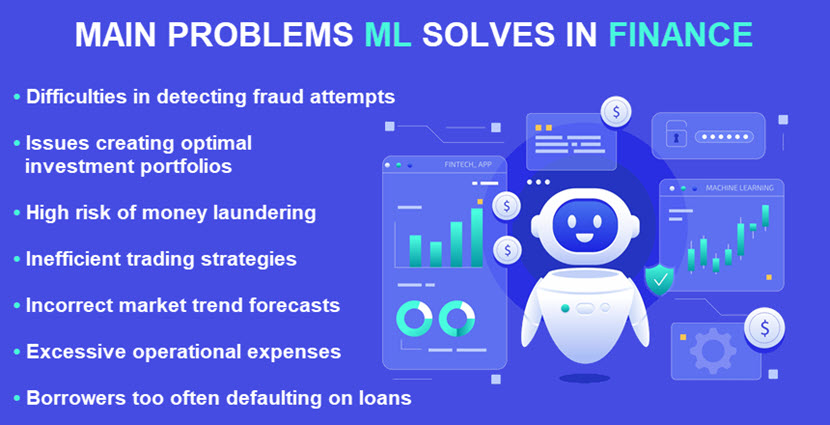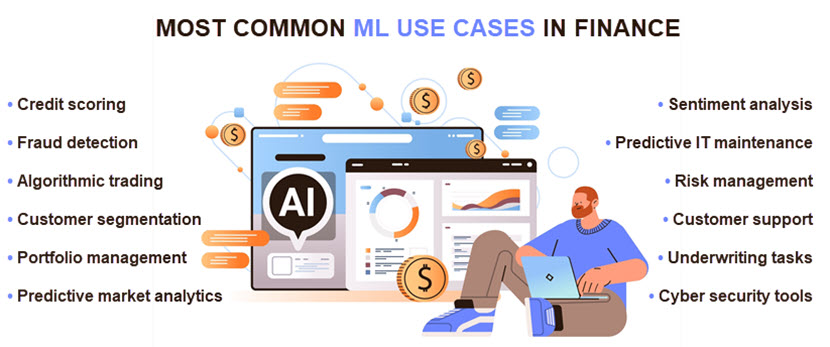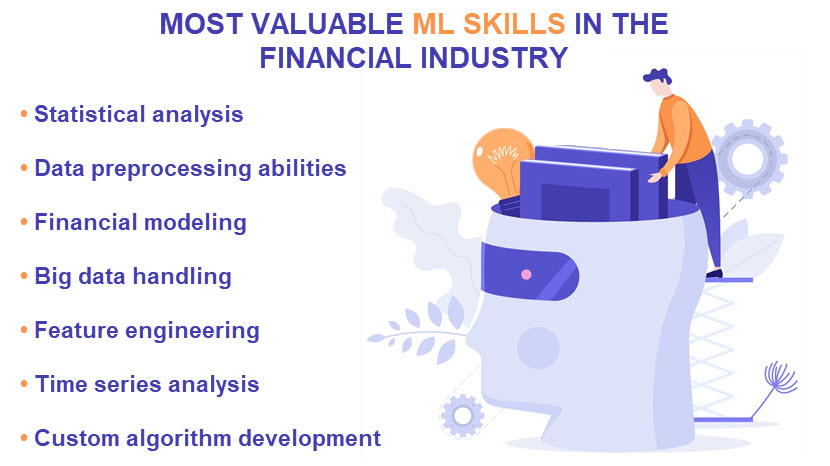The integration of machine learning (ML) into the financial industry has been nothing short of transformative. ML's capability to analyze vast data sets is revolutionizing the way financial institutions operate and make decisions.
Thanks to ML, financial institutions can now predict market trends with unprecedented accuracy, manage risks more effectively, and reduce operational costs. Meanwhile, customers enjoy faster and more personalized financial services tailored to their needs.
This article provides an in-depth look at the role of machine learning in finance and explores the profound impact this AI technology is having on the financial industry. Jump in to see how companies in the financial sector use ML algorithms to enhance operations with data-driven insights and predictions.

Thinking about pursuing a career in ML development? Check out machine learning projects you can use to get some hands-on experience and build a portfolio that will make you stand out during job interviews.
Utilization of Machine Learning in Finance
Machine learning is an integral part of the financial industry, enabling organizations to enhance efficiency, accuracy, and decision-making processes. Companies in this sector primarily use machine learning algorithms to analyze large volumes of data. ML models use this in-depth analysis to perform one of two tasks:
- Make predictions. Many companies use ML to make data-driven predictions, such as anticipating stock price movements, predicting credit scores, or estimating the likelihood of loan defaults.
- Recognize patterns. Machine learning models are adept at identifying intricate patterns in massive data sets. These patterns enable financial institutions to gain deeper insights into market behavior, customer preferences, and operational inefficiencies.
Data-driven patterns and predictions allow financial institutions to accurately assess market trends, identify risks, and optimize business strategies. Machine learning models also enable organizations to automate various routine processes, such as:
- Data entries.
- Transaction processing.
- Compliance checks.
- Portfolio management and asset allocation.
- Document analysis.
- Credit scoring and loan approvals.
- Contract reviews.
Automating repetitive and time-consuming tasks reduces the likelihood of human error. Automation also leads to faster decision-making, which is essential in the fast-paced financial market.
The integration of ML with other technologies, such as big data tools and artificial intelligence (AI), enables companies to create more sophisticated financial models and applications. These integrations allow companies to develop advanced predictive analytics platforms, robo-advisors, and automated trading systems that adapt to market changes in real-time.

Types of Machine Learning in Finance
Financial organizations use several types of ML to analyze available data and make predictions. Below is an in-depth look at the most commonly used types of machine learning in finance.
Supervised Learning
Supervised learning is a type of ML in which admins train algorithms on labeled data. Every input data point is paired with a correct output, so the model learns to make connections between variables based on provided samples.
For example, a labeled data set in finance could consist of historical loan applications, where each application (input) is labeled with the outcome of whether the loan was repaid or defaulted (output).
Supervised learning plays a critical role in predictive modeling and decision-making. Here are the most common uses for supervised learning in the financial sector:
- Predicting the likelihood of a borrower repaying a loan based on historical data.
- Anticipating future stock prices based on historical market data.
- Evaluating potential risks associated with investments.
- Recognizing patterns indicative of fraudulent activities.
- Identifying potential customers for specific financial services.
The biggest downside to supervised learning is that this approach requires large volumes of labeled data, which is expensive and time-consuming to gather.
Unsupervised Learning
Unsupervised learning is a type of ML in which admins train models on unlabeled data. Since input data has no corresponding outputs, the model must identify patterns within the provided data without relying on human-prepared labels.
In finance, unsupervised learning is essential for uncovering patterns in large, chaotic data sets. By analyzing data without specific labels, unsupervised ML models discover insights that may not be obvious to human analysts.
Here are the most common use cases for unsupervised learning in the financial industry:
- Identifying unusual transactions or activities.
- Analyzing transactions to identify products or services that are frequently purchased together.
- Grouping customers based on shared characteristics.
- Uncovering hidden risk factors that may not be apparent through traditional analysis.
- Discovering optimal ways to diversify investments based on asset performance.
Like in all other industries, organizations in the financial sector often use unsupervised learning for exploratory data analysis (EDA). EDA aims to uncover hidden insights or groupings within data, which helps humans understand available information and prepare labels for supervised learning.
Our comparison of supervised and unsupervised machine learning offers an in-depth look at the main differences between the two primary ML methodologies.
Semi-Supervised Learning
Semi-supervised learning is a type of ML in which admins train a model on a small database of labeled information and a large amount of unlabeled data. The model leverages the labeled data to guide its learning process, but it also must independently extract patterns from the unlabeled data set.
In finance, semi-supervised learning is the go-to option for scenarios where labeled data is scarce or too costly to obtain. Here are a few everyday use cases for semi-supervised learning:
- Predicting the likelihood of loan defaults by leveraging a small set of labeled credit histories combined with a large pool of unlabeled customer data.
- Analyzing financial news articles to gauge market sentiment using a limited set of labeled sentiment data to enhance the model's accuracy on a vast amount of unlabeled content.
- Identifying fraud attempts by using labeled examples of fraudulent transactions alongside a broader set of transaction data that lacks specific labels.
- Identifying investment strategies by analyzing both labeled historical performance data and a wide range of unlabeled market indicators.
- Enhancing loan approval strategies by combining a few labeled cases with a large data set of unlabeled loan applications.
By combining the strengths of both labeled and unlabeled learning, semi-supervised learning offers a cost-effective and efficient solution for various use cases in finance.
Reinforcement Learning
Reinforcement learning is a type of ML in which an algorithm learns by interacting with its environment and receiving feedback in the form of rewards or penalties. The model aims to maximize cumulative rewards over time, which enables it to learn through trial and error.
Reinforcement learning algorithms excel in dynamic environments that require continuous real-time adjustments. Here are a few common financial use cases for this type of machine learning:
- Developing trading strategies that autonomously adjust to market conditions to maximize returns.
- Continuously reallocating assets in a portfolio to achieve the best possible returns.
- Implementing dynamic hedging techniques that minimize losses caused by market fluctuations.
- Determining the optimal distribution of assets across different classes to balance risk and reward over time.
Reinforcement learning enables organizations to adapt to changing market conditions and improve decision-making processes. However, the complexity of designing practical reward functions makes this approach the least common type of machine learning in finance.
No matter what type of learning you choose for your ML project, you can use machine learning libraries to build models without having to write massive amounts of code from scratch.
What Are the Benefits of Machine Learning in Finance?
Machine learning provides significant value to the financial industry, as ML enables companies to interpret data more effectively and utilize it. Below are the most notable benefits of machine learning in finance:
- Enhanced decision-making. ML models can analyze vast amounts of data to provide valuable insights and predictions. Financial institutions use this information to make more informed decisions.
- Improved risk management. Machine learning enables more accurate risk assessments. ML models reliably identify potential risks and anomalies that might be missed by traditional methods, which is crucial in areas like credit scoring, fraud detection, and market analysis.
- Increased efficiency. Automation of routine tasks allows financial institutions to operate more efficiently. Companies can also free up human resources for more strategic activities.
- Personalized customer experiences. By analyzing customer behavior and preferences, ML models help financial institutions offer more personalized services and products. As a result, companies have an opportunity to increase revenue and improve customer satisfaction.
- Adaptability to market changes. Machine learning models quickly adapt to new data and changing market conditions, which is vital for any company operating in the financial market.
- Cost reductions. Automation and improved accuracy reduce operational costs by minimizing errors, streamlining processes, and improving overall efficiency.
While highly beneficial, AI also introduces a fair amount of problems. Check out our article on AI risks to see the main dangers of overly relying on ML and other AI technologies.
How Is Machine Learning Used in Finance?
Machine learning has a variety of applications in the financial industry. Below is a list of the top 12 most common use cases for machine learning in finance.

Credit Scoring
Machine learning enables more accurate and dynamic evaluations of an individual's or a business's creditworthiness.
Traditional credit scoring methods rely on static models that use a limited set of variables. In contrast, machine learning algorithms can analyze vast amounts of data to assess creditworthiness.
In addition to standard variables like credit history and income, ML algorithms can also analyze alternative data sources like:
- Social media activity (online behavior, social connections, interactions, etc.).
- Spending and income patterns.
- Behavioral patterns (lifestyle choices, spending habits, financial management, etc.).
- Utility and rental payment records.
- Employment history.
- Education and professional qualifications.
- Public records (legal judgments, bankruptcies, liens, etc.).
- Online shopping behavior.
- Geolocation data.
By processing this extensive data, machine learning models identify complex patterns and correlations that traditional models often miss. Deeper analysis allows for a more nuanced and personalized credit risk assessment, leading to more precise predictions about the likelihood of default or late payments.
Fraud Detection
Financial institutions train fraud detection models on historical data that combines both legitimate and fraudulent transactions. This data allows a model to learn the subtle differences between standard and suspicious behavior (both for users and systems).
Whenever a model detects unusual patterns or deviations from typical behavior, the transaction in question gets flagged or canceled. This process occurs in real-time to reduce the window for fraudulent activities.
Better accuracy in distinguishing between legitimate and fraudulent transactions reduces the rate of false positives. Financial institutions minimize the disruption to customers by reducing the likelihood of legitimate transactions being flagged as fraud attempts.
Algorithmic Trading
Many organizations use machine learning models to automate trading decisions and execute trades at high speeds. Models analyze market conditions in real-time and identify trading opportunities by leveraging complex algorithms and vast data sets.
Machine learning models help financial organizations make better trading decisions by performing the following tasks:
- Identifying patterns and trends in market data that signal buying or selling opportunities.
- Forecasting future price movements based on historical and real-time data.
- Executing trades within milliseconds to capitalize on minute price fluctuations (so-called high-frequency trading (HFT)).
- Assessing and managing risks by optimizing trading strategies and minimizing potential losses.
Using machine learning in algorithmic trading leads to improved trading performance, fewer errors in judgment, and the potential for higher returns on investments (ROI).
Customer Segmentation
Customer segmentation involves dividing a customer base into different groups based on shared characteristics, behaviors, or preferences.
By leveraging machine learning, financial institutions create highly accurate customer segments. Models analyze various data points to cluster customers into meaningful segments based on the following factors:
- Demographic information (age, gender, location, income, etc.).
- Spending patterns, frequency of purchases, and transaction amounts.
- Engagement metrics (interactions with marketing materials, website visits, response rates, etc.)
Once a company establishes segments, it becomes better able to develop targeted marketing campaigns that resonate with target customers. It also becomes easier to offer tailored financial products, such as personalized loan offers or investment portfolios.
High levels of personalization enable financial institutions to increase customer engagement, improve conversion rates, and foster stronger relationships with users thanks to more relevant offerings.
Portfolio Management
Machine learning models can process various data types, including financial statements, market trends, economic indicators, and unstructured data (e.g., news articles and social media sentiment). Models use this in-depth analysis to optimize portfolios by predicting asset performance and adjusting allocations in real-time to balance returns and risks.
Here are the most common applications of machine learning in portfolio management:
- Determining the optimal distribution of assets based on market conditions and investor goals.
- Continuously assessing portfolio risk by identifying potential threats.
- Forecasting future market trends and asset performance.
- Dynamically adjusting the portfolio to maintain the desired asset allocation as market conditions change.
The use of machine learning leads to more effective portfolio management, allowing investors to make investment decisions with more confidence.
Predictive Analytics for Market Trends
Machine learning models utilize time series analysis and regression techniques to uncover trends and relationships within data. By learning from past data, models generate predictions about future market conditions, asset prices, and investment opportunities. Financial organizations use these predictions to:
- Forecast future price movements based on historical price data and market indicators.
- Anticipate macroeconomic trends (e.g., GDP growth, inflation, interest rates) to inform investment decisions.
- Forecast demand for financial products and services.
- Predict customer churn rates and come up with suitable user retention strategies.
Check out our article on regression algorithms to learn exactly how machine learning models make accurate predictions based on provided data.
Sentiment Analysis
Sentiment analysis involves processing and analyzing text data (e.g., news articles, social media posts, financial reports) to determine the overall tone towards a particular asset, market, or economic event. The tone can be positive, negative, or neutral.
Organizations use ML models trained in natural language processing (NLP) to recognize and interpret the nuances in language that indicate sentiment. This analysis is critical in finance as market sentiment can significantly impact asset prices and investor behavior.
Here are the most common uses for ML-powered sentiment analysis in the financial industry:
- Using sentiment data to anticipate market movements.
- Identifying potential risks by detecting negative sentiment trends before they affect the market.
- Correlating sentiment shifts with stock price fluctuations to predict future performance.
- Understanding public and investor sentiment to forecast market reactions to news and events better.
ML-driven sentiment analysis enables financial professionals to make more informed decisions, react quickly to market changes, and gain a competitive edge with more effective trading strategies.
Predictive Maintenance for Financial IT Infrastructure
Many companies use machine learning models to analyze data related to IT infrastructure, such as server performance metrics, network traffic, and system logs.
Models identify anomalies that signal potential issues, which enables teams to take timely action before problems impact operations and cause downtime. Here are a few examples of how companies use ML to detect infrastructure-related issues:
- Monitoring system metrics (e.g., CPU usage, memory usage, disk health) to identify deviations from standard operating patterns.
- Assessing system performance and resource utilization to optimize the allocation of IT resources and prevent overloading.
- Analyzing historical data on hardware and software failures to predict when and where failures might occur.
- Using predictions to schedule maintenance activities during off-peak hours automatically.
ML-based predictive maintenance for financial IT infrastructure helps prevent unexpected system downtimes, reduces the risk of operational disruptions, and enhances overall system reliability.
Risk Management and Compliance
Organizations in the financial industry often use machine learning algorithms to assess credit, market, and operational risks.
Machine learning models analyze real-time data, such as market movements, transaction histories, and economic indicators, to detect early warning signs of potential risks. This timely analysis enables financial organizations to reliably:
- Evaluate the likelihood of borrower default by analyzing a wide range of financial and behavioral data.
- Identify internal process failures or external threats that could impact financial stability.
- Predict market volatility and potential losses, helping adjust investment strategies and hedge risks.
Machine learning also helps institutions adhere to regulatory requirements by monitoring transactions, detecting suspicious activities, and ensuring that all operations comply with relevant laws. Many companies use ML-based monitoring to ensure adherence to anti-money laundering (AML) laws and Know Your Customer (KYC) regulations.

Customer Support Automation
In the financial industry, customer support automation typically involves the use of ML-powered chatbots and virtual assistants. These systems can handle a wide range of inquiries, from handing out basic account information to performing complex transaction queries.
Machine learning models are trained on vast data sets of customer interactions, enabling them to understand and respond to a variety of questions and requests. By leveraging advanced algorithms and NLP, financial institutions can automate routine customer service tasks, providing instant responses through chatbots that offer 24/7 availability.
ML-powered chatbots and virtual assistants are also often trained to offer tailored financial advice and product suggestions based on customer preferences and behavior.
Insurance Underwriting
Traditional underwriting processes rely on fixed criteria and manual assessments, which are time-consuming and limited in scope. Machine learning enhances these processes by analyzing large data sets and using advanced algorithms to improve decision-making.
In insurance underwriting, machine learning models assess policy issuance risks by analyzing diverse data, including historical claims, customer profiles, and external factors such as weather patterns. This in-depth analysis allows insurers to:
- Accurately estimate the likelihood of future claims.
- Determine appropriate insurance premiums by evaluating individual risk profiles.
- Offer customized insurance products and coverage options based on individual risk assessments.
Many companies also use machine learning to identify potentially fraudulent insurance claims by recognizing unusual patterns and anomalies in claim data.
Cyber Security Tools
The financial sector is a prime target for cyber attacks due to the vast amounts of personal and financial information held by companies. Machine learning enables businesses to create advanced precautions for detecting, preventing, and responding to cyber threats.
Financial organizations often use machine learning models to analyze vast amounts of data from network traffic, user behavior, and transaction records to identify indicators of potential threats. These models are trained on historical data of known attack vectors and cyber incidents, but they can also recognize signs of novel attacks and threat strategies.
Here are a few common uses for ML in the cybersecurity niche:
- Identifying unusual patterns in network traffic that may indicate a data breach.
- Detecting dangerous activities by analyzing transaction patterns.
- Analyzing threat data to predict and identify emerging cyber threats and vulnerabilities.
- Monitoring and analyzing user behavior to detect deviations from standard patterns.
Many financial organizations also automate response procedures in case of an incident. Automated ML systems respond to threats in real-time and take suitable precautions, such as isolating affected systems, blocking transactions, or asking users for additional authentication.
Are you worried about your company's online assets? Boost your cyber security levels by migrating important data to our award-winning Data Security Cloud, a highly secure cloud infrastructure platform we built in collaboration with Intel and VMware.

How Big Is Machine Learning in the Finance Market?
The machine learning market in the finance industry is substantial and growing rapidly. Financial institutions are increasingly adopting ML technologies to improve efficiency, enhance decision-making, and stay competitive, and the market reflects this trend:
- The market size of AI in fintech was estimated at $42.83 billion in 2023 and currently sits at approximately $44.08 billion in 2024.
- In 2023, organizations in the financial industry invested an estimated $35 billion in AI, which is a clear indicator that AI technologies are delivering results in this sector.
- Around 48% of businesses in the financial sector use machine learning models to manage large data sets and enhance decision-making processes.
The growth of machine learning in finance is driven primarily by:
- Increasing investments in ML solutions.
- There is a need for enhanced security and operational efficiency.
- A surge in demand for data-driven insights.
- A competitive drive in which companies are more willing to adopt ML technologies to avoid falling behind competitors.
The three areas currently seeing the most investments in terms of ML are fraud detection, algorithmic trading, and risk management.
North America, particularly the United States, is the largest market for machine learning in finance. The US market is driven primarily by the presence of major financial institutions and tech companies. Europe and the Asia-Pacific region are also experiencing strong growth, with increasing adoption of ML technologies in all financial hubs.
Enjoying these articles that analyze the use of AI technologies within a specific industry? If so, check out our post on the use of AI in healthcare for some further reading.
What Is the Future of Machine Learning in Finance?
The future of machine learning in finance is poised to be highly dynamic in the coming years. Here is what you should expect to see in the near future:
- Increased adoption. Financial institutions will continue to expand their use of ML across various functions. The technology's ability to analyze vast amounts of data and make accurate predictions will drive deeper integration into day-to-day operations.
- Advanced algorithms. The development of more sophisticated ML algorithms (especially deep learning models) will enhance predictive accuracy and decision-making capabilities. These advancements will enable more effective management of complex financial data and diverse scenarios.
- Greater emphasis on data privacy. With the expansion of machine learning in finance, there will be a heightened focus on data privacy and security. Companies will need to implement robust measures to protect sensitive customer data and comply with privacy regulations.
- Greater automation. The adoption of ML will lead to further automation of financial processes, which will result in increased operational efficiency and reduced costs.
- Enhanced personalization. Financial institutions will continue to use ML to provide more personalized financial products and services. By analyzing individual customer data and behavior, firms can offer more tailored investment advice, credit offers, and insurance products.
- Ethical and regulatory challenges. As ML becomes more prevalent, financial institutions will face increased scrutiny regarding the ethical use of AI and compliance with regulations. In the coming years, ensuring transparency, fairness, and accountability in ML models will be critical.
- Integration with other technologies. The convergence of ML with other emerging technologies, such as blockchain and quantum computing, will open new opportunities for innovation in finance.
Ethical concerns are among the most notable challenges of ML and AI adoption. Check out our post on AI ethics to see what precautious companies can take to ensure responsible and sustainable use of AI systems.
What Are the Problems with Machine Learning in Finance?
Machine learning in finance offers many advantages, but it also comes with a few challenges that hinder its effective use. Here are some of the most notable problems associated with ML in finance:
- Data quality and availability. The success of ML models relies heavily on high-quality data. In finance, data sets are often incomplete, inaccurate, or biased, which leads to unreliable model predictions.
- Model interpretability issues. Many advanced ML models have hard-to-interpret decision-making processes. In finance, where transparency is critical, this lack of interpretability is a significant drawback. The opacity of ML models also makes it challenging to meet regulatory requirements.
- Data privacy issues. The extensive use of personal data in ML financial models raises considerable privacy concerns. Companies must be extremely careful with how they collect, store, and use data.
- Compatibility issues. Many financial institutions rely on legacy systems that are not compatible with modern ML technologies. Integrating ML models with these systems is often complex and costly.
- Ethical concerns. The use of machine learning in finance raises ethical questions about fairness and accountability. These concerns arise from the real-world impact of these models, as they make decisions that significantly affect individuals' lives, such as loan approvals or insurance underwriting.
- High costs. Companies require considerable computational resources to train and run ML models. The high cost of the necessary equipment is a common barrier for potential adopters.
Read the SpyFu case study to see how migrating AI workloads to phoenixNAP's Bare Metal Cloud helped the company cut its infrastructure costs by 50%.
A New Era of Financial Services
The ability to analyze vast amounts of information and make data-driven predictions is reshaping the way financial institutions operate. As machine learning continues to evolve, its integration into finance will only deepen. Expect financial institutions to continue exploring the use of machine learning as they attempt to provide more personalized and efficient services than their competitors.



